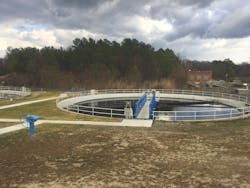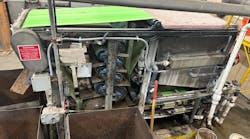Casey Whittier is product manager of BioMag & CoMag Systems for Evoqua Water Technologies LLC. Whittier can be reached at [email protected].
As part of the Chesapeake Bay Restoration Act’s Enhanced Nutrient Removal (ENR) initiative, the Marlay-Taylor Water Reclamation facility, a regional wastewater treatment plant for the Lexington Park, Hollywood and Piney Point areas of St. Mary’s County located in Maryland was faced with the need to find a cost-effective solution to achieve this initiative. The requirements included meeting future total nitrogen (TN) and total phosphorus (TP) limits, while maintaining the plant’s 6 million gallons per day (mgd) rated capacity.
At the time, the Marlay-Taylor Water Reclamation facility treated an average flow of 4 mgd. The existing facility was designed to treat an annual average daily flow of 6 mgd, a max monthly flow of 8 mgd, a max daily flow of slightly more than 15 mgd and a peak hourly flow of 20 mgd. The existing facility also included influent screening, grit removal, primary clarification, two aeration tanks, four secondary clarifiers and chlorine gas disinfection. The secondary treatment system was made up of two aeration trains with each train configured as a four-stage Bardenpho with retrievable fine bubble tube diffusers in the first three aerobic zones and retrievable coarse bubble diffusers in the re-aeration zone.
More Treatment & Clarification
Through a collaborative effort between the utility operating the facility, MetCom, two consulting engineering firms, Dewberry, Brown and Caldwell, and Evoqua, a solution was developed to retrofit the existing single stage system into a four-stage Bardenpho. It was concluded that the Evoqua BioMag system, a ballasted activated sludge process, would be the ideal solution to allow for the stable operation across a wide range of flows and also remove phosphorus in the effluent.
The BioMag System enhances biological wastewater treatment processes by using magnetite to ballast biological floc. With a specific gravity of 5.2 and a strong affinity for biological solids, magnetite substantially increases the settling rate of the biomass. Increasing the settling rates of the biological floc provides the opportunity to increase mixed liquor suspended solids (MLSS) concentration. Higher MLSS concentrations enable more treatment capacity, all within the same tankage. The BioMag system serves as an ideal application for activated sludge plants, which need more treatment capacity or enhanced treatment removal capability.
Design Basis
The full-scale BioMag system starts with waste pumped from either clarifier underflow or surface wasting that is sent to an intermediate thickener or holding tank. This tank allows for flexibility in wasting rates and allows for both a portion of underflow and surface waste to be utilized. This tank can also be bypassed entirely. The waste is then pumped by two of three double-disc diaphragm pumps to the four shear mills and four magnetic recovery drums. The operators have the option to send flow through any number and combination of the shear mills and drums. The recovered magnetite then slides down a chute where it is mixed with raw magnetite in a tank before being returned to aeration basins. The system typically uses ferric chloride with single point addition into the aeration tanks prior to the secondary clarifiers to meet its TP limit. Another available option is adding polymer into the clarifier splitter box, which the plant operates at an average dose of 0.68 mg/L active polymer.
Operating Results
Since the BioMag system came online in early 2016, it has operated in overloaded conditions and under wet weather spring flows, as the second train was taken offline and upgraded. Prior to the installation of the BioMag system, heavy rain events would have caused biological oxygen demand (BOD) and total suspended solids (TSS) values to surpass 100 mg/L, overwhelming the system. After installing the BioMag system, a rain of 3.3 inches caused flows to surpass 15 mgd, while a daily total of slightly more than 7 mgd was observed. Due to the system, there were no issues with high flows, and in turn, there was no need for an operator to remain on site after hours to manage issues.
Figure 1 (above) shows the plant’s effluent TSS concentrations since the BioMag system was operational. Effluent TSS concentrations have ranged from 1 to 7 mg/L TSS, with an average effluent TSS concentration of 2.9 mg/L, indicating excellent and consistent treatment overall. With the low TSS performance, the BOD5 concentrations have also performed well as those concentrations range from 1 mg/L to 9 mg/L, with an average of 2.7 mg/L.
The TN removed is enhanced through carbon addition and has averaged 2.9 mg/L average daily effluent TN since this has come online. Figure 2 (page 28) walks through the reduction in TN with the commencement of the new system, charging the system with magnetite, and the addition of a glycerin-based carbon source.
While the main goal of implementing the BioMag system at the Marlay-Taylor Facility was to remove phosphorous, the reduction in TSS in effluent has also improved TP in the effluent.
The Marlay-Taylor Water Reclamation facility is one of the first full-scale BioMag systems with anaerobic digestion. As a result, there have been interesting findings around the destruction of volatile solids. While the majority of magnetite is returned back to the activated sludge process, there is a small fraction that makes its way past the recovery drums with the waste activated sludge. The plant has observed upwards of a 10% increase in volatile solids reduction, since the BioMag system came online.
The upgrade of the Marley-Taylor Water Reclamation facility has allowed the plant to achieve ENR standards (i.e. the tighter 5 ppm BOD, 5 ppm TSS, 3 ppm TN, 0.3 ppm TP effluent limits). In the past, storm flows would have created and led to deteriorating water quality. Since the BioMag system upgrade, the plant has pushed the average daily secondary clarifier surface overflow rate up to 1,300 gallons per day per square foot while maintaining effluent limits. Additionally, the BioMag system has allowed for stable operation across the wide range of flows the plant encounters.



